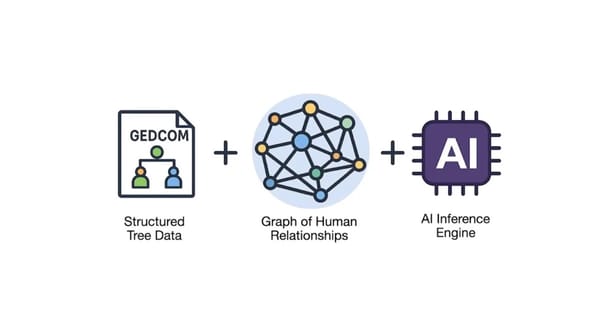When most people think about forensic genetic genealogy, autosomal DNA testing is most often what comes to mind. Autosomal SNP (single nucleotide polymorphism) testing, which examines genetic material inherited from both parents, is the primary tool for identifying genetic relatives across multiple branches of a family tree. While this type of testing is the foundation of forensic genetic genealogy, other DNA markers—such as mitochondrial DNA (mtDNA) and Y-chromosome DNA (Y-DNA) markers—provide additional context and can enhance an investigation. These lineage-specific markers allow investigators to focus in on maternal or paternal lines, helping to narrow the search for a person of interest more effectively as well as more quickly. Best of all, these DNA markers are included for no additional cost in comprehensive DNA tests like Othram's Forensic-Grade Genome Sequencing®.
In this post, we’ll explore how mtDNA and Y-DNA testing work, what they can be used for, and how they complement autosomal DNA testing to accelerate and refine forensic investigations. When you use Othram's Multi-Dimensional Forensic Intelligence (MDFI) platform, you get all the tools you need to maximize the use of mtDNA and Y-DNA testing for your case.
Maternal Lineage and Haplogroups
Mitochondrial DNA (mtDNA) is found in the mitochondria of cells and is inherited exclusively from the mother. Unlike autosomal DNA, which recombines with each generation, mtDNA remains relatively unchanged as it passes along the maternal line, providing a direct link to maternal ancestors. This stability makes mtDNA an effective tool for human identification by tracing the maternal lineage, especially when nuclear DNA is unavailable or highly degraded.
Traditionally, mtDNA testing focused on two hypervariable regions, HVR1 and HVR2, which contain significant genetic variation useful for distinguishing maternal lines. However, modern forensic applications often employ full mitochondrial genome sequencing, which analyzes all 16,569 base pairs of the mitochondrial genome. This comprehensive approach offers greater resolution for identifying distant maternal relatives and assigning individuals to specific mitochondrial haplogroups.

Haplogroups represent branches of the human family tree, defined by shared genetic variants that trace back to a common maternal ancestor. These variants are predominantly single nucleotide polymorphisms (SNPs) but also include insertions and deletions. Haplogroups provide information about an individual’s biogeographical ancestry, indicating where their maternal lineage originated. For example, a haplogroup associated with Sub-Saharan Africa or East Asia may provide investigators with valuable contextual clues about the individual’s historical origins.
Full mitochondrial genome sequencing also enables forensic scientists to distinguish to a degree between closely related individuals within the same haplogroup, providing finer resolution for maternal lineage analysis.
Tracing the Paternal Lineage and Surname Analysis
Y-DNA testing focuses on the Y chromosome, which is passed virtually unchanged from father to son. This makes it an excellent tool for tracing paternal lineage. Y-DNA testing can be performed using Y-STRs (short tandem repeats) or Y-SNPs, each offering unique advantages:
- Y-STR Testing: Ideal for identifying close paternal relatives, such as fathers, sons, or brothers.
- Y-SNP Testing: Offers higher resolution, enabling investigators to trace deeper ancestral connections or confirm specific lineages.
Modern sequencing efforts, such as FamilyTreeDNA’s BigY test, provide comprehensive Y-chromosome sequence data, analyzing thousands of SNPs across the Y chromosome. This level of detail allows for precise haplogroup assignment and provides insight into paternal ancestry, lineage splits, and resolution of unrelated individuals within the same haplogroup.
One particularly useful application of Y-DNA testing in forensic investigations is surname analysis. Since surnames often follow the paternal line, a Y-DNA profile can sometimes suggest a specific surname. For example, if a Y-DNA test reveals a match to a surname associated with a distinct Y-DNA profile, this information can guide genealogical research towards a specific family line, narrowing the pool of potential relatives.
Haplogroups: Understanding Lineage and Ancestry
Haplogroups represent branches of the human family tree, defined by shared genetic variants that trace back to a common ancestor. Both mtDNA and Y-DNA haplogroups provide valuable insights into an individual's maternal and/or paternal ancestry, offering clues about deep ancestral origins and migration patterns.
In mtDNA testing, haplogroups are determined by analyzing specific SNPs and patterns of variation within the mitochondrial genome. Each haplogroup corresponds to a distinct set of genetic markers inherited along the maternal line. These markers are compared against reference databases of known haplogroups to assign an individual to a specific branch of the mtDNA phylogenetic tree.
Similarly, Y-DNA haplogroups are determined by analyzing SNPs and other genetic variants on the Y chromosome. These haplogroups follow the paternal line and are structured in a hierarchical tree, with major branches representing ancient lineages and smaller subgroups reflecting more recent ancestral splits. Modern sequencing tests, such as Forensic-Grade Genome Sequencing®, can refine haplogroups to their most specific subclades, providing a detailed view of paternal ancestry.

Haplogroups aid forensic investigations by providing biogeographical clues, supporting genealogical research, and refining population representation. They add a valuable layer of context, narrowing possibilities and guiding investigations more effectively.
Complementing Autosomal SNP Testing with mtDNA and Y-DNA
While autosomal SNP testing is the primary method for identifying genetic relatives, mtDNA and Y-DNA testing can substantially enhance and accelerate forensic genetic genealogy investigations. For example, autosomal SNP testing may identify distant relatives, but mtDNA or Y-DNA results can confirm whether the connection lies along the maternal or paternal line.
In cases involving degraded samples or incomplete nuclear DNA, mtDNA and Y-DNA testing provide additional data that can guide genealogical research. For instance:
- Narrowing the Search Space: mtDNA results might confirm a maternal association, eliminating irrelevant paternal branches of the family tree. Similarly, Y-DNA results may identify a paternal haplogroup or surname, focusing efforts on the paternal side.
- Reducing the Need for Reference Testing: By providing lineage-specific information, mtDNA and Y-DNA results can reduce trial-and-error testing of potential relatives, saving time and resources.
- Facilitating Tree Construction: Lineage data from mtDNA or Y-DNA can help pinpoint the most recent common ancestor, streamlining the process of building family trees and identifying connections.
Conclusion
Both mtDNA and Y-DNA testing can be effective tools in the forensic genetic genealogy toolkit, offering insights that autosomal SNP testing alone cannot provide. By tracing direct maternal and paternal lines, these methods confirm relationships, suggest surnames, and support genealogical research. When combined with autosomal SNP testing, they can accelerate forensic investigations, enabling law enforcement to connect evidence to individuals with greater speed and accuracy.
Remember, when working cold cases we should expect, and in fact demand, this complete genomic analysis because every detail matters and any detail could be a clue. Don't miss out on this additional information. If you are not getting a complete analysis from your vendors or internal methods, or if you are not ready to onboard this new technology in your own forensic setting yet, come to Othram.
Our team operates the world's first purpose-built forensic laboratory for forensic genetic genealogy. We developed Forensic-Grade Genome Sequencing® or FGGS® to enable ultra-sensitive detection of distant relationships and it includes all the markers you will need – autosomal, mtDNA, and Y. It's part of our Multi Dimensional Forensic Intelligence (MDFI) platform.
More forensic genetic genealogy cases have been solved with Othram FGGS® than any other method. Let’s work together to unlock answers and bring justice to those who need it most. Get started here.






